|
Cardiovascular Laboratory |
Blood Pressure>
Auscultatory Method |
| |
The relaxed subject sits on a chair with the lower arm
supported as before. The blood pressure cuff is placed on the subject's right arm,
allowing 1 inch between the bottom of the cuff and the crease of the elbow. |
| |
The brachial pulse is palpated just above
the angle of the elbow (the "antecubital
fossa"). |
|
One group member puts on a stethoscope, with the earpieces
on the headpiece angled forward. The recording end of the stethoscope is twisted, so that
the diaphragm and not the bell is activated. This can be tested by tapping lightly
on the diaphragm. |
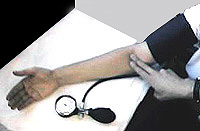 |
|
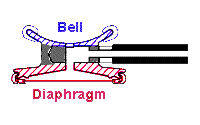
|
The diaphragm is placed over the brachial artery in the
space between the bottom of the cuff and the crease of the elbow. At this point no sounds
should be heard. |
 |
|
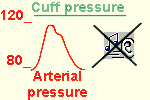
|
|
The cuff pressure is inflated quickly to a
pressure about 30 mm Hg higher than the systolic pressure determined by
the method of palpation. Then the air is let out of the cuff at a rate such that cuff pressure falls at a
rate of about 5 mm Hg/sec.
At some point the person listening with the stethoscope
will begin to hear sounds with each heartbeat. This point marks the systolic
pressure.
The sounds are called Korotkoff sounds. |
|
|
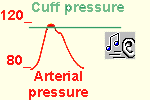
|
|
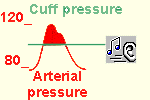
|
As the pressure is lowered further, the character of the
Korotkoff sounds should change. At some point, the sounds will disappear.
The
pressure reading at this point gives the diastolic pressure. |
|
|
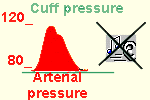
|
|
The subject should now lie on his or her back for five
minutes. The systolic pressure and diastolic pressure are recorded. Then the
subject stands up, and the pressures are immediately recorded once more. |
Explanatory
Notes
The laminar flow that normally occurs in
arteries produces little vibration of the arterial wall and therefore no sounds.
However, when an artery is partially constricted, blood flow becomes turbulent, causing the artery
to vibrate and produce sounds.
|
|
When measuring blood pressure using the
auscultation method, turbulent blood flow will occur when the cuff pressure is greater
than the diastolic pressure and less than the systolic pressure. The
"tapping" sounds associated with the turbulent flow are known as Korotkoff
sounds. Remember that these sounds are not to be confused with the heart sounds
produced by the opening and closing of the heart valves. |
|
Summary of the
auscultatory method: |
|
Initially the cuff is inflated to a level higher than the
systolic pressure. Thus the artery is completely compressed, there is no blood flow,
and no sounds are heard. The cuff pressure is slowly decreased. At the point
where the systolic pressure exceeds the cuff pressure, the Korotkoff sounds are
first heard and blood passes in turbulent flow through the partially constricted artery.
Korotkoff sounds will continue to be heard as the cuff pressure is
further lowered. However, when the cuff pressure reaches
diastolic pressure, the sounds disappear. Now at all points in
time during the cardiac cycle, the
blood pressure
is greater than the cuff pressure, and the artery remains open. |
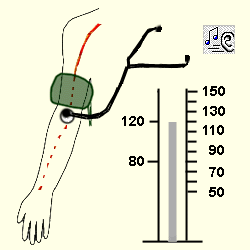
|
|
|
>>For a QuickTime video with sound, click here
>>For an avi video with sound, click here |
|
JNC Classification
of blood pressure in adults |
|
Classification |
BP (mm Hg) |
| Normal |
systolic: less than 120
diastolic: less than 80 |
| Pre-hypertension |
120-139/80-89 |
| Stage 1 hypertension |
140-159 (systolic)
or
90-99 (diastolic) |
| Stage 2 hypertension |
equal or more than 160
(systolic)
equal or more than 100 (diastolic) |
|
JNC: Joint
National Committee on Prevention, Detection, Evaluation,
and treatment of high blood pressure |
|
Errors in blood pressure readings:
The cuff is not of the proper size: if the cuff is too small
the blood pressure readings may be artefactually high. If the cuff is
too big, the readings may be artefactually low.
The cuff is positioned too loosely: the blood pressure may be
artefactually high.
The centre of the cuff bladder is not positioned over the brachial
artery.
The cuff is inflated slowly: a slow inflation causes venous
congestion, which in turn causes the Korotkoff sounds to be faint; this
results in false readings with the systolic value being too low and the
diastolic reading too high.
If the cuff is re-inflated immediately after an initial reading
(trying to re-check the reading): a rapid re-inflation could cause
venous distension, the Korotkoff sounds become more muffled. The initial
Korotkoff sound may be missed so the systolic reading would be falsely
low, and the diastolic reading would be falsely high because the last
Korotkoff sounds could not be heard. |
|
|
|
To continue with the next section:
the Electrocardiogram, click here |